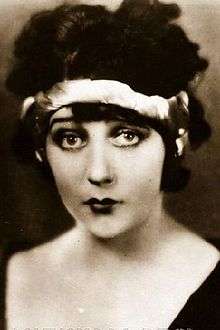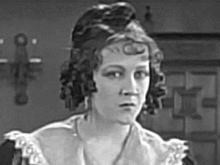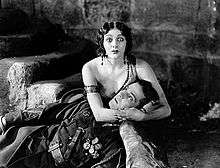Barbara La Marr
| Barbara La Marr | |
|---|---|
 La Marr, circa 1920 | |
| Born |
Reatha Dale Watson July 28, 1896 Yakima, Washington, U.S. |
| Died |
January 30, 1926 (aged 29) Altadena, California, U.S. |
| Cause of death | Tuberculosis and nephritis |
| Resting place | Hollywood Forever Cemetery |
| Other names |
Barbara La Marr Deely Folly Lytell |
| Occupation | Actress, cabaret artist, screenwriter |
| Years active | 1920–1926 |
| Spouse(s) |
Jack Lytell (m. 1913; d. 1914) Lawrence Converse (m. 1914; d. 1914) Phil Ainsworth (m. 1916; div. 1918) Ben Deeley (m. 1918; div. 1921) Jack Dougherty (m. 1923) |
| Children | 1 |
Barbara La Marr (July 28, 1896 – January 30, 1926) was an American film actress, noted for her beauty and her tempestuous marital history.
After some early experience in vaudeville, she became a screenplay writer, and then a performer, appearing with Douglas Fairbanks and others in over thirty movies, as well as dancing on Broadway. Her hedonistic lifestyle in Hollywood, with heavy drug dependence, led to her early death.
Early life
La Marr was born in 1896 as Reatha Dale Watson to William Wallace and Rosana "Rose" Watson in Yakima, Washington (La Marr later claimed she was born in Richmond, Virginia).[1] Her father was an editor for a newspaper, and her mother had a son, Henry, born in 1878, and a daughter, Violet, born in February 1881, from a previous marriage. The couple wed some time during 1884, and had a son, William Watson, Jr., born in June 1886 in Washington. In the 1920s, Watson became a vaudeville comedian under the stage name of "Billy Devore." The Watsons lived in various locations during La Marr's formative years. By 1900, she was living with her parents in Portland, Oregon, with her brother William, her half-sister Violet Ross, and Violet's husband Arvel Ross. As a child, La Marr also performed in a few stage productions and performed as a dancer in vaudeville.[1]
By 1910, La Marr was living in Fresno, California, with her parents. Some time after 1911, the family moved to Los Angeles. In January 1913, La Marr's half-sister, now going by the name of Violet Ake, took her 16-year-old sister on a three-day automobile excursion with a man named C.C. Boxley. They drove up to Santa Barbara, but after a few days La Marr felt that they were not going to let her return home. Ake and Boxley finally let La Marr return to Los Angeles after they realized that there were warrants issued for their arrests accusing them of kidnapping. This episode was published in several newspapers, and La Marr even testified against her sister, but the case was eventually dropped.
La Marr's name appeared frequently in newspaper headlines during the next few years. In November 1914, she came back from Arizona and announced that she was the newly widowed wife of a rancher named Jack Lytell and that they were supposedly married in Mexico. As legend goes, Lytell became enamored of La Marr as he saw her one day riding in an automobile while he was out on horseback. He rode up to her car and swept her on his horse and rode off with her. They were married the next day. She also stated that she loathed the name Reatha and preferred to be called by the childhood nickname "Beth."
Career

After marrying and moving with her second husband to New York City, La Marr found employment writing screenplays at Fox studios using the name "Folly Lytell".[2] Her association with filmmakers led to her returning to Los Angeles and making her film debut in 1920. Over the next few years she acted frequently in films, and was known as "The Girl Who Is Too Beautiful," after a Hearst newspaper feature writer, Adela Rogers St. Johns, saw a judge sending her home during the police beat in Los Angeles because she was too beautiful and young to be on her own in the big city. This publicity did much to promote her career.[3]
La Marr made the successful leap from writer to actress in Douglas Fairbanks' The Nut (1921), appeared in over thirty films, wrote seven screenplays for United Artists and Fox Film Corporation, and danced in musical comedies on Broadway. She is also said to have filmed dancing shorts in New York City, Chicago, and Los Angeles, with such diverse partners as Rudolph Valentino and Clifton Webb.
Among La Marr's films are The Prisoner of Zenda and Trifling Women, both 1922 releases directed by Rex Ingram. Although her film career flourished, she also embraced the fast-paced Hollywood nightlife, remarking in an interview that she slept no more than two hours a night. La Marr also began abusing drugs and alcohol and reportedly developed a cocaine and heroin habit. Her lifestyle eventually began to affect her career and she was dropped by M-G-M. La Marr signed with First National Pictures where she appeared in three films which proved to be her last.[2]
Personal life

La Marr was married five times. She married her first husband, Jack Lytell, in 1914 at the age of 17. Lytell died of pneumonia a few weeks after the marriage. La Marr married for a second time, on June 2, 1914, to lawyer Lawrence Converse. Converse was already married with children when he married La Marr and was arrested for bigamy the following day. While in jail, Converse repeatedly banged his head on his cell wall while calling for La Marr and knocked himself unconscious. He died of a blood clot in his brain on June 5. In 1916, La Marr married dancer Phil Ainsworth. Ainsworth was sent to San Quentin for passing bad checks. They divorced in 1917. La Marr married for a fourth time to Ben Deely in 1918. They separated in April 1921. Before the divorce from Deely was finalized, La Marr married actor Jack Dougherty in May 1923. They remained married until La Marr's death.[2]
Some years after her death, it was revealed that she had given birth to a son. The name of the boy's father has never been publicly released. The child, Marvin Carville La Marr, was adopted after La Marr's death by the actress ZaSu Pitts and her husband, film executive Tom Gallery. He was renamed Don Gallery.[4]
Final years
By 1925, La Marr's drug and alcohol use began to take its toll. She developed nephritis and tuberculosis.[5] On January 30, 1926, she died of complications associated with tuberculosis and nephritis at her parents' home in Altadena, California, at the age of 29.[6] She was interred in a crypt at Hollywood Cathedral Mausoleum, in the Hollywood Forever Cemetery.[4]
For her contribution to the motion picture industry, La Marr has a star on the Hollywood Walk of Fame at 1621 Vine Street.[6]
Filmography
| Year | Title | Role | Notes |
|---|---|---|---|
| 1920 | Harriet and the Piper | Tam O'Shanter Girl | Credited as Barbara Deely Alternate title: Paying the Piper |
| 1920 | Flame of Youth | Story | |
| 1920 | The Mother of His Children | Story Credited as Barbara La Marr Deely | |
| 1920 | Rose of Nome | Story Credited as Barbara La Marr Deely | |
| 1920 | The Little Grey Mouse | Story | |
| 1920 | The Land of Jazz | Story Credited as Barbara La Marr Deely | |
| 1921 | The Nut | Claudine Dupree | |
| 1921 | Desperate Trails | Lady Lou | |
| 1921 | The Three Musketeers | Milady de Winter | |
| 1921 | Cinderella of the Hills | Kate Gradley | Credited as Barbara La Marr Deely |
| 1922 | Arabian Love | Themar | |
| 1922 | Domestic Relations | Mrs. Martin | |
| 1922 | The Prisoner of Zenda | Antoinette de Mauban | |
| 1922 | Trifling Women | Jacqueline de Séverac/Zareda | |
| 1922 | Quincy Adams Sawyer | Lindy Putnam | |
| 1923 | The Hero | Hester Lane | |
| 1923 | The Brass Bottle | The Queen | |
| 1923 | Mary of the Movies | herself | |
| 1923 | Poor Men's Wives | Laura Bedford/Laura Maberne | |
| 1923 | Souls for Sale | Leva Lemaire | |
| 1923 | Strangers of the Night | Anna Valeska | Alternate title: Ambrose Applejohn's Adventure |
| 1923 | St. Elmo | Agnes Hunt | |
| 1923 | The Eternal Struggle | Camille Lenoir | Alternate title: Masters of Women |
| 1923 | The Eternal City | Donna Roma | |
| 1924 | Thy Name Is Woman | Guerita | |
| 1924 | The Shooting of Dan McGrew | Lady Known as Lou | |
| 1924 | The White Moth | Mona Reid/The White Moth | Writer, uncredited |
| 1924 | Hello, 'Frisco | ||
| 1924 | Sandra | Sandra Waring | |
| 1924 | My Husband's Wives | Story | |
| 1925 | The Heart of a Siren | Isabella Echevaria | Alternate title: The Heart of a Temptress |
| 1925 | The White Monkey | Fleur Forsyte | |
| 1926 | The Girl from Montmartre | Emilia Faneaux | |
In popular culture
- In the 1930s, Louis B. Mayer named the actress Hedy Lamarr after Barbara La Marr, who had been one of his favorite actresses.[3]
- La Marr is referred to in the Flanagan and Allen song "Underneath the Arches" during the break when Ches Allen reads out the headlines from a 1926 newspaper.
- La Marr's former Hollywood Hills home was featured on the HGTV series Secrets from a Stylist. The house was featured in the 2011 episode "Hollywood Regency Meets Country Club Chic."
- Children's author, Edward Eager, sets an episode of his 1954 book, "Half Magic", at a showing of Barbara La Marr's "Sandra" and includes some ironic description of the movie.
Further reading
- Michael G. Ankerich (2010). Dangerous Curves atop Hollywood Heels: The Lives, Careers, and Misfortunes of 14 Hard-Luck Girls of the Silent Screen. BearManor. ISBN 1-59393-605-2.
References
- Notes
- 1 2 Soares, André (2010). Beyond Paradise: The Life of Ramon Novarro. Univ. Press of Mississippi. p. 34. ISBN 1-604-73458-2.
- 1 2 3 Donnelley, Paul (2003). Fade to Black: A Book of Movie Obituaries. Music Sales Group. p. 389. ISBN 0-711-99512-5.
- 1 2 Barton, Ruth (2010). Hedy Lamarr: The Most Beautiful Woman in Film. University Press of Kentucky. p. 63. ISBN 0-813-12610-X.
- 1 2 (Donnelley 2003, p. 390)
- ↑ Allan R., Ellenberger (2009). Ramon Novarro: A Biography of the Silent Film Idol, 1899-1968; with a Filmography. McFarland. p. 68. ISBN 0-786-44676-5.
- 1 2 "Hollywood Star Walk". latimes.com.
- Bibliography
- 1900 United States Federal Census, Portland Ward 7, Multnomah County, Oregon, June 1, 1900, Enumeration District 66, Sheet 1B.
- 1910 United States Federal Census, Fresno, Township 3, California, April 22, 1910.
- The Duluth News Tribune, "Stolen Twice, Is Now Widow", November 17, 1913.
- Oakland Tribune, "Two Are Accused Of Kidnapping Girl", January 5, 1913, Page 39.
- Los Angeles Times, "Serious Charge Against Couple. Child Stealing Complaint Issued", January 5, 1913, p. 11.
- Los Angeles Times, "Alleged Child Stealers Surrender Themselves.", January 7, 1913, p. 3.
- Los Angeles Times, "Girl Missing: Warrants Out. Absent Maid's Father Takes Drastic Action.", January 3, 1913, p. 13.
External links
| Wikimedia Commons has media related to Barbara La Marr. |
- Barbara La Marr at the Internet Movie Database
- Barbara La Marr at Find a Grave
- Barbara La Marr at Virtual History
- funeral of Barbara LaMarr(archived)